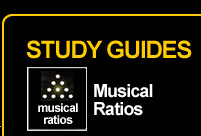






Pythagorean tuning is a system of musical tuning in which the frequency relationships of all intervals are based on the ratio 3:2. Its discovery is generally credited to Pythagoras. It is the oldest way of tuning the 12-note chromatic scale and, as such, it is the basis for many other methods of tuning.
Pythagorean tuning is based on a stack of perfect fifths, each tuned in the ratio 3:2, the next simplest ratio after 2:1, which is the ratio of an octave. The two notes A and D, for example, are tuned so that their frequencies are in the ratio 3:2 — if D is tuned to 200 Hz, then the A is tuned to 300 Hz. The E a fifth above that A is also tuned in the ratio 3:2 — with the A at 300 Hz, this puts the E at 450 Hz, 9:4 above the original D. When describing tunings, it is usual to speak of all notes as being within an octave of each other, and as this E is over an octave above the original D, it is usual to halve its frequency to move it down an octave. Therefore, the E is tuned to 225 Hz, a 9:8 above the D. The B a 3:2 above that E is tuned to the ratio 27:16 and so on, until the starting note, D, is arrived at again.
In applying this tuning to the chromatic scale, however, a problem arises: no number of 3:2s will fit exactly into an octave. Because of this, the D arrived at after twelve fifths have been tuned up is about a quarter of a semitone sharper than the D used to begin the process. The below table (starting at E flat rather than D) illustrates this, showing the note name, the ratio above D, and the value in cents above the D for each note in the chromatic scale. The cent values of the same notes in equal temperament are also given for comparison (marked in the table below as "et-Cents").
In order to keep the ratios in this table relatively simple, fifths are tuned down from D as well as up. The first note in the circle of fifths given here is E flat (equivalent to D#), from which five perfect fifths are tuned before arriving at D, the nominal unison note.
In equal temperament, and most other modern tunings of the chromatic scale, pairs of enharmonic notes such as E flat and D sharp are thought of as being the same note — however, as the above table indicates, in Pythagorean tuning, they theoretically have different ratios, and are at a different frequency. This discrepancy, of about 23.5 cents, or one quarter of a semitone, is known as a Pythagorean comma.
To get around this problem, Pythagorean tuning uses the above 12 notes from E flat to G sharp shown above, and then places above the G sharp another E flat, starting the sequence again. This leaves the interval G#—Eb sounding badly out of tune, meaning that any music which combines those two notes is unplayable in this tuning. A very out of tune interval such as this one is known as a wolf interval. In the case of Pythagorean tuning, all the fifths are 701.96 cents wide, in the exact ratio 3:2, except the wolf fifth, which is only 678.49 cents wide, nearly a quarter of a semitone flatter.
Wolf_fifth.ogg (33.1KB) is a sound file demonstrating this out of tune fifth. The first two fifths are perfectly tuned in the ratio 3:2, the third is the G#—Eb wolf fifth. It may be useful to compare this to Et_fifths.ogg (38.2KB), which is the same three fifths tuned in equal temperament, each of them tolerably well in tune.
If the notes G# and Eb need to be sounded together, the position of the wolf fifth can be changed (for example, the above table could run from A to E, making that the wolf interval instead of Eb to G#). However, there will always be one wolf fifth in Pythagorean tuning, making it impossible to play in all keys in tune.
Because of the wolf interval, this tuning is rarely used nowadays, although it is thought it was once widespread. In music which does not change key very often, or which is not very harmonically adventurous, the wolf interval is unlikely to be a problem, as not all the possible fifths will be heard in such pieces.
Because fifths in Pythagorean tuning are in the simple ratio of 3:2, they sound very "smooth" and consonant. The thirds, by contrast, which are in the relatively complex ratios of 81:64 (for major thirds) and 32:27 (for minor thirds), sound less smooth. For this reason, Pythagorean tuning is particularly well suited to music which treats fifths as consonances, and thirds as dissonances. In classical music, this usually means music written prior to the 16th century. As thirds became to be treated as consonances, so meantone temperament, and particularly quarter comma meantone, which tunes thirds to the relatively simple ratio of 5:4, became more popular. However, meantone still has a wolf interval, so is not suitable for all music.
From around the 18th century, the need grew for instruments to change key, and therefore to avoid a wolf interval, this led to the widespread use of well temperaments and eventually equal temperament.
Tetraktys
The Tetractys, also known as the decad, is a triangular figure consisting of ten points arranged in four rows: one, two, three, and four points in each row. As a mystical symbol, it was very important to the followers of the secret worship of the Pythagoreans.
Pythagorean symbol
The Tetractys symbolized the four elements - earth, air, fire, and water.
The first four numbers also symbolized the harmony of the spheres and the Cosmos.
The first four numbers added up to ten, which was unity of a higher order.
The Tetractys represented the organization of space:
__the first row represented zero-dimensions (a point)
__the second row represented one-dimension (a line of two points)
__the third row represented two-dimensions (a plane defined by a triangle __of three points)
__the fourth row represented three-dimensions (a triangular pyramid __defined by four points)
A prayer of the Pythagoreans shows the importance of the Tetractys (sometimes called the "Mystic Tetrad"), as the prayer was addressed to it.
"Bless us, divine number, thou who generated gods and men! O holy, holy Tetractys, thou that containest the root and source of the eternally flowing creation! For the divine number begins with the profound, pure unity until it comes to the holy four; then it begets the mother of all, the all-comprising, all-bounding, the first-born, the never-swerving, the never-tiring holy ten, the keyholder of all".
As a portion of the secret religion, initiates were required to swear a secret oath by the Tetractys. They then served as novices for a period of silence lasting three years.
The Pythagorean oath also mentioned the Tetractys:
"By that pure, holy, four lettered name on high,
nature's eternal fountain and supply,
the parent of all souls that living be,
by him, with faith find oath, I swear to thee."
The Pythagorean SourceBook claimed that there were 2 quaternaries of numbers, one which is made by addition, the other by multiplication; and these quaternaries encompass the musical, geometric and arithmetic ratios of which the harmony of the universe so composed. The first quartenary is 1,2,3,4. There are 11 total quartenaries. And the perfect world which results from these quaternaries is geometrically, harmonically and arithmetically arranged.
It is said that the Pythagorean musical system was based on the Tetractys as the rows can be read as the ratios of 4:3, 3:2, 2:1, forming the basic intervals of the Pythagorean scales. Pythagorean scales are based on pure fifths (in a 3:2 relation), and pure fourths (in a 4:3 relation) which form a stable optimally blending intervals. The ratios of 1:1 and 2:1 generate stable purely blending intervals.
Quote:
"The Tetractys [also known as the decad] is an equilateral triangle formed from the sequence of the first ten numbers aligned in four rows. It is both a mathematical idea and a metaphysical symbol that embraces within itself — in seedlike form — the principles of the natural world, the harmony of the cosmos, the ascent to the divine, and the mysteries of the divine realm. So revered was this ancient symbol that it inspired ancient philosophers to swear by the name of the one who brought this gift to humanity — Pythagoras."
— Attributed to Iamblichus
This article is licensed under the GNU Free Documentation License. It uses material from the Wikipedia article "Mathematics of musical scales", Wikipedia article "Pythagorean Tuning" and Wikipedia article "Tetraktys".




